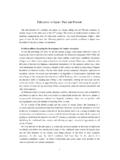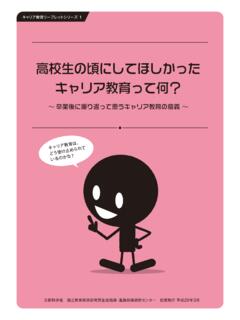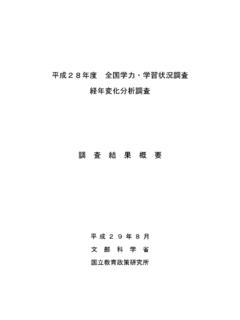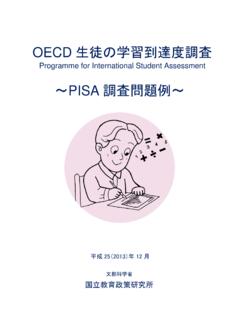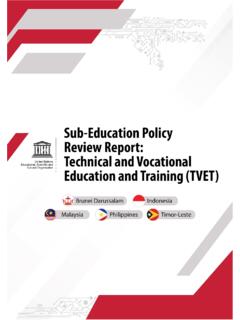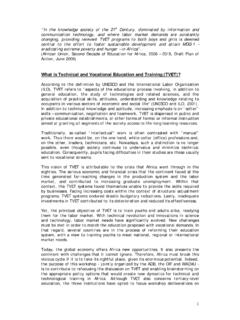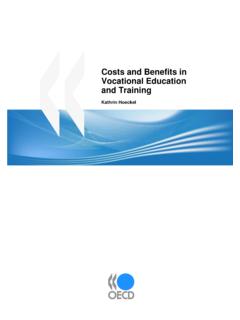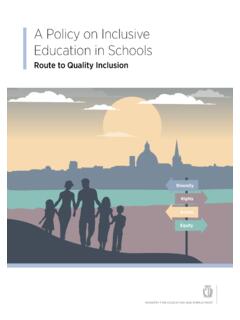Transcription of Distinctive Features of Japanese Education System
1 Distinctive Features of the Japanese Education System Thus there is a general belief that a student s performance in one crucial examination at about the age of 18 is likely to determine the rest of his life. In other words: the university entrance examination is the primary sorting device for careers in Japanese society. The result is not an aristocracy of birth, but a sort of degree-ocracy (OECD, Reviews of National Policies for Education : JAPAN. 1971 ) What are the Distinctive Features of the Japanese Education System ? Explaining the characteristics and Features of the Japanese Education System to readers from other countries is not an easy task. In the process of educational development, Japan modeled its System after the developed countries in the West, and introduced many elements of the school System from those countries. Japan has a well-developed educational System in which the structure and function has much in common with many other industrialized countries.
2 However, it is possible to identify some characteristics that are particular to the Japanese System . In the tradition and culture of Japan, some parts of the Education System often function differently from those in other countries. In its social context, some functions of the Education System have been excessively exploited, and other functions have been relatively disregarded. At the same time, Distinctive Features represent both the strengths and weaknesses of the Japanese Education System . While with the passage of time some Features have changed, other Features have remained unchanged for many decades. As a point of departure, we discuss one notable work treating this topic. In an article published in 1990, Prof. Shogo Ichikawa of the National Institute for Educational Policy Research (NIER) attempts to analyze the characteristics of the Japanese Education System through comparison with the United States, Europe and other countries in East Asian, pointing out eight Features of the Japanese System .
3 Twenty years have passed since this article. Have the main Features of the System changed during this period? In the first section, we will discuss Ichikawa s analysis, following which we will reexamine the Distinctive Features of Japanese System in terms of common Features and changes during the last two decades. 1. Eight Distinctive Features by Ichikawa s analysis In 1990, Ichikawa enumerated the Distinctive characteristics of the Japanese Education System as follows. (1) The way that schooling and school Education dominate children s and young people s lives; (2) the privatized development of pre- and post-compulsory Education and the large share of private funding for Education ; (3) the preference for general Education under a single-track System ; (4) automatic promotion between the grades based on age; (5) the low enrollment of non- Japanese students and adults in schools; (6) the high educational achievement with low level of deviation; (7) the unique screening function of entrance examinations; and (8) the practice of autonomous school management.
4 Let us consider each item in greater detail based on his arguments. The statistics cited by Ichikawa, which will therefore be included here, are those of the time of his writing. The way that schooling and school Education dominate children s lives One of the most Distinctive Features of Japanese Education is that schooling is highly prevalent among the people, and occupies a position of great weight in children s and the young people s lives. Compulsory Education (primary and lower secondary Education ) is universally completed. Moreover, 95% of teen-agers go on to upper secondary Education . And 38% of the upper secondary school graduates advance to higher Education . Thus, with respect to total school enrollment rates, Japan ranks high even among the developed countries. Furthermore, Japanese children spend a greater amount of time at school. In compulsory Education , schools are in operation for as many as 240 days a year including Saturdays.
5 In teaching hours per week, Japan is on par with the average for industrialized countries. Japanese students, however, tend to stay in school after school hours to participate in extra-curricular activities or to play sports or games with their classmates, and some do not leave until the evening. In addition, Japanese students have quite a bit of homework to do. And the majority engage in various kinds of out-of-school learning activity such as private cram schools (Juku), private tutoring, correspondence Education , and private cultural lessons. They devote most of their spare time to preparation or review for their lessons at school. Schools often supervise the lives of their students out of school. Some schools occasionally send teachers and volunteer parents to patrol the streets and downtown area to protect against vicious practices and juvenile delinquency. Generally, the parents and the other people in the community expect the schools to play an extensive role and to assume a heavy responsibility including instilling discipline and moral standards in their students.
6 The privatized development of pre- and post-compulsory Education and the large share of private funding for Education The second feature is the considerable development of private educational institutions and the large share of private funding that goes to Education . At the compulsory Education level, the proportion of students attending private primary and lower secondary schools is only about and 3 , respectively. This is smaller than that in European countries and many other developing countries. At these levels of Education , public schools certainly dominate. Meanwhile, at the upper secondary Education and higher Education levels, share of enrollment in private institutions grows higher and higher. Particularly, at the higher Education level, enrollment in the private institutions of higher Education is eminently high. Private enrollment constitutes about 72% of university enrollment, 90% of junior college enrollment and 93% of specialized training schools.
7 These private higher Education institutions charge a fair amount of tuition fees, and it falls on the student s households to cover them. The Japanese government has adopted a policy that favors compulsory Education by giving it a greater share in its Education budget. For example, in the United States, nearly 30% of public educational expenditures are allotted to higher Education , but in Japan, the proportion is only 10%. Also, 76% of kindergartens, which are not a part of the compulsory Education System in Japan, are in the private sector. The predominance of the private sector at both ends of the Education System is a unique feature of Japanese Education . In addition, a great many of Japanese children go to private cram schools on evenings and/or weekends to supplement or catch up with their school lessons. Also, many students attend various kinds of private training centers to take lessons on such activities as playing the piano, painting, dance, swimming, computes, and calligraphy.
8 There exists a large market for these educational industry . These learning activities amount to no small expenses for the household. Generally, Japanese families prioritize their children s Education and show a great readiness to invest in schooling. As a result of the relatively equitable distribution of income throughout the period of high economic growth, the average household has become able to bear these educational expenses without experiencing too heavy a burden. The Preference for general Education under a single-track System The third feature is that schools offer a common (general Education -oriented) curriculum for all students under a single-track System . At the upper secondary Education level, students have the option of academic (general), vocational , and specialized programs, but the content of the curricula does not vary widely with the type of program. Japan s single-track school System dates back to 1872 when first modern Education regulation (the Education System Ordinance) was set forth.
9 Since that time, Japan has maintained the principle of not splitting the first stage of Education into two subsystems, one for the elite and one for the masses. Although at the first stage of development of Education in the 19th century, there were various types of programs and schools for elementary Education , the national government was able to establish a System of common ordinary elementary schools for all children by 1900. The task of establishing a comprehensive secondary Education System was achieved in 1943 when the government promulgated The Secondary School Order . The idea underlying this order was that no class distinction should be drawn between general Education and vocational Education or between schools for boys and schools for girls. The government declared that Japanese institutions for secondary Education were all equal in status, with differences only in curriculum. Japan s effort at unifying secondary Education had, therefore, already met with success during the Second World War.
10 At the primary and lower secondary Education levels, all schools offer a general Education , and students are not given the opportunity for vocational training . At the upper secondary Education level, general, vocational and specialized programs (agriculture, industry, commerce, fishing, home economics, nursing, and social services, etc.) are provided. The proportion of students enrolled in academic programs has been increasing, and in 1990, it accounted for nearly three-quarters of all students. Furthermore, even in the vocational programs, more than half of the total teaching hours are allotted to non- vocational academic subjects. Contrary to the image that other countries have of Japan, Japanese school Education is remarkably free from narrow vocational skill training . In general, Japanese companies and factories have their own in-company training systems, and they tend to demand that graduates who are hired into the companies have acquired basic and fundamental competencies.
